On the 23andMe website, “Relatives In Common” between you and a DNA relative are people who share DNA with both of you.
These are also known as Shared Matches. This article starts with the basics. Then we walki you through some powerful techniques for using Relatives In Common to help your family research.
Where is the “Relatives In Common” display?
You have to go through a few clicks to find the list of Relatives In Common. Follow these steps to find the feature.
- Open the Relative Profile page of any person on your DNA Relatives list.
- Scroll down to the bottom of the page.
- Click on the “Find Relatives In Common” button.

Why Do Some Matches Have No Relatives In Common?
You won’t see a list for all your DNA Relatives, particularly your more distant ones.
23andMe has a basic threshold of 5 centimorgans for Relatives In Common. Aside from this limit, they are pulled from your list of relatives which is capped at about 1,500 people (or 5,000 if you have the premium level).
So, at the lower end of your DNA Relatives list, the shared matches can fall out of the requirements.
Easy Ways To Use Relatives In Common For Family Research
You can use some powerful research techniques with Relatives in Common that we’ll cover later in this article.
But first, we’ll run through some of the easier ways to get started with their benefits.
Separate paternal and maternal relatives
Many people won’t have a parent who has also tested on 23andMe.
But hopefully, you’ll recognize where a few of your top DNA relatives sit in your family tree.
If you know that a match is on your mother or father’s side, then you at least start with the knowledge that your Relatives in Common are paternal or maternal. That narrows down your research to half your family tree!
Of course, this doesn’t work so well if there was intermarriage across both sides of your family.
More chances to get information for one branch
Let’s say that you’re intrigued by a DNA relative who has listed a surname that you’ve been researching. You think that this relative could knock down a brick wall!
Unfortunately, in our example scenario you get no replies to your messages.
But this isn’t the end of the road. Scroll down through the pages of Relatives In Common and you may spot some DNA matches that are closely related to your target.
You could find 23andMe users predicted to be a brother or first cousin to your silent relative.
Now you have more targets in this family branch of interest. If it’s the brother of a female relative who uses her married name, now you have a useful surname to add to your research.
If it’s a first cousin who has also provided surnames in their family background section, you can start to build up a family tree for this branch.
Even if you don’t get far with the information on 23andMe, you now have more people to send messages to. All it takes to smash that brick wall is for one of them to send you a good family tree.
Triangulating With Your Relatives In Common
The Relatives In Common feature on 23andMe gives you a sophisticated tool to help with triangulating your DNA matches in order to research the most recent common ancestor.
You may not have encountered the concept of triangulation using DNA. This section walks through a simple example on 23andMe.
Example scenario
My closest unknown relative on 23andMe is Jennifer, with a predicted relationship of 3rd cousin.
Nicole is at the top of our list of Relatives In Common. This means that Nicole shares a segment of identical DNA with me. She also shares DNA with Jennifer.
There are several ways that our little group of three may be connected. The ideal for our research is that it’s through a recent common ancestor.
However, that isn’t the only way. But we’ll look at it first.
Recent Common Ancestor
We may all have inherited the same piece of DNA passed down through generations from a common ancestor.
The diagram below shows one section of DNA passed down unchanged through four generations. Myself, Jennifer, and Nicole inherit this small identical piece of DNA.
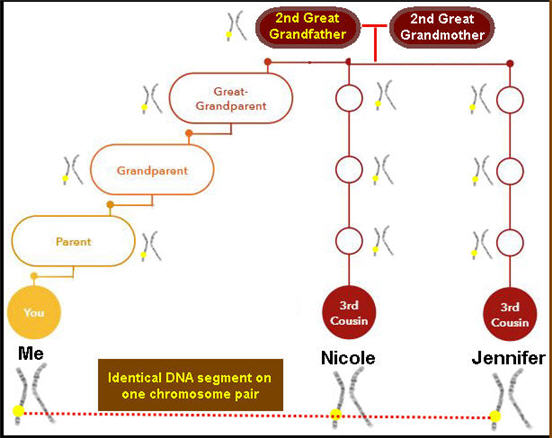
The segment happens to come from our 2nd great-grandfather.
But suppose I don’t know the family relationships. What use are Relatives In Common who share the same identical segment of DNA?
Well, this is where we start our genealogy research.
On 23andMe, I’ll be looking for a common surname and/or location details provided by my two relatives. I’ll reach out to them in the hope that one or both has a rich family tree that they will share with me.
But fools rush in where…etc, etc. I’ve missed a vital step before jumping into family research.
Although Jennifer, Nicole, and I share an identical segment of DNA, I can’t assume that we descend from the same recent ancestors.
How can that be? Read on.
Identical DNA on different chromosomes
In our diagram above, I’m showing a chromosome pair with an identical piece of DNA on one of the two chromosomes that we inherit from our parents.
Wite each chromosome pair, we get one copy from our father and one from our mother.
But 23andMe and the other commercial DNA testing companies can’t tell which is which.
Suppose I have identical DNA with Nicole at positions X to Y on one chromosome. And I share DNA with Jennifer at the same position but on the other chromosome within the pair.
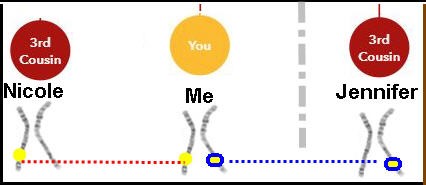
Nicole is my 3rd cousin on one side of my family, while Jennifer is on the other side.
In the above diagram, Nicole and Jennifer aren’t related at all. They both share DNA with me, but not with each other.
Sharing DNA in different locations
Now let’s take another scenario. In the diagram below, I’ve shifted the position of the shared DNA between myself and Jennifer (in blue).
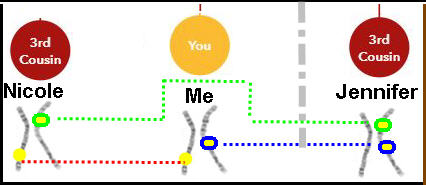
Now, let’s say that Jennifer and Nicole share DNA with each other on a different segment (shown in green) or on a completely different chromosome pair. I don’t share this piece.
They are related to each other but not through one of my ancestors.
Jennifer and I will have Nicole as a Relative In Common (she’s related to both of us).
But if I rush into researching how Nicole and Jennifer are related, I’ll disappear down the wrong rabbit hole. Their common line isn’t part of my pedigree.
So, how can I tell if my Relatives In Common share a recent common ancestor?
The key is that the shared DNA is in the same or overlapping positions on a chromosome pair when we compare each of us to each other.
Overlapping DNA
You’ll probably see the term “triangulation” pop up as you learn more about different DNA tools. This website has several articles on the topic!
Basically, triangulation means comparing the positions of shared DNA segments between three or more DNA relatives.
If they overlap significantly, we have identified a triangulated group with a shared common ancestor.
Overlapping DNA
When I’m talking about shared DNA segments, why do I say “overlap”? Because the start and end positions of the shared DNA won’t align exactly.
23andMe gives us an advanced Chromosome Browser that shows how shared DNA stacks up across up to five relatives.
You can check out our in-depth article on using the different 23andMe chromosome browsers for triangulation. I’ll give a brief example here.
This picture shows an excerpt of the browser with five of my DNA relatives. The colored areas show the start and end position of shared DNA with me on our 7th chromosome pair.

We all share some portion of overlapping DNA. As long as the overlapping pieces are big enough, then I have a good triangulated group here.
Now, let’s get back to my example of Jennifer and Nicole. I could use the chromosome browsers to examine the locations of our shared DNA.
However, the Relatives In Common display gives us a shortcut.
DNA Overlap In The Relatives In Common Display
DNA Overlap is the last column in the Relatives In Common Display.
This is where 23andMe is doing a lot of work on your behalf to check if the three relatives form a triangulated group.
You will see several different statuses in this column.
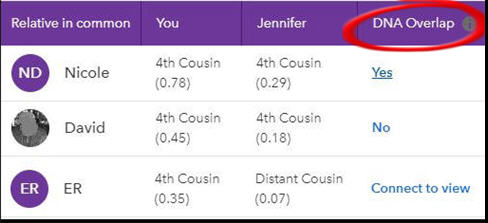
What does Yes mean in the DNA Overlap column?
Yes means that you, your relative, and your Relative In Common share DNA in the same area of a chromosome pair.
This is exactly what you want to see! 23andMe is saying that you have a triangulated group.
However, you can’t always take this as gospel with more distant DNA relatives.
You should click on the “Yes” link and take a look at the size(s) of the overlapping segments. The very small segments could be due to chance.
What does No mean in the DNA Overlap column?
No means that you share DNA at different positions on your chromosomes.
When you click on the No link, you’ll see what’s going on. In the excerpt below, I share DNA with Jennifer on the 7th chromosome pair and with David on the 9th.

Is there overlap? No!
What does Connect to View mean in the DNA Overlap column?
23andMe users can choose not to show their segment details to all their DNA relatives.
So, you don’t know at this point if you have overlapping DNA or not.
If you click on the Connect link here, all that happens is that 23andMe brings you to the DNA Relative profile. Here, you can send a Connect request to this user.
If they accept your request, you will be able to see their DNA layout and 23andMe can calculate your Yes/No details for you.
What does Not Available mean in the DNA Overlap column?
You may see “Not Available” all the way down the Overlap column.
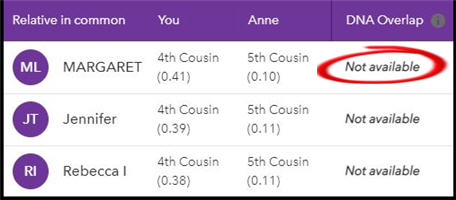
What’s going on?
Sometimes it seems to be a temporary glitch with the website. Try coming back a bit later and refreshing the page.
Other Articles On Triangulation On 23andMe
23andMe gives you other ways to triangulate DNA matches.
We have a walkthrough of using the 23andMe DNA Relatives spreadsheet for triangulation.
We also have a tutorial on doing triangulation with the 23andMe chromosome browsers.
Thank you Margaret for taking the time to write this piece. I have previously tested or uploaded my dna results to the other sites and have been working on my matches etc.
When I came to 23andMe at the end of last year I found it not intuitive what I should do or how it worked. I had worked out a bit but you post made me go back and try again. So thank you. I had more success in what I was doing and found a match which will hopefully help me to add to on my current goal.
Thank you! Best of luck with your research.